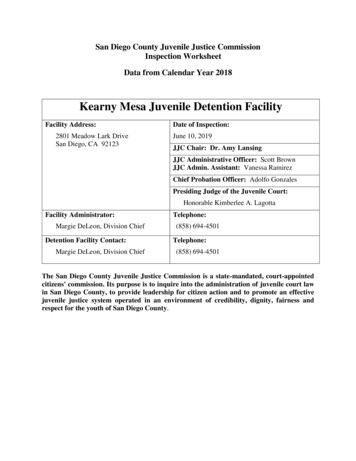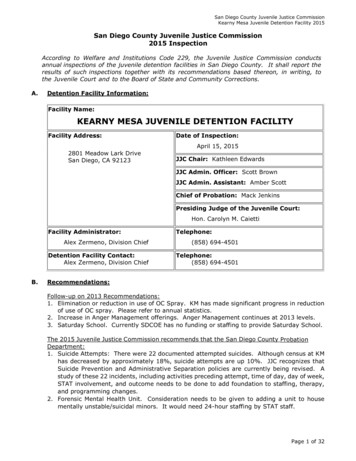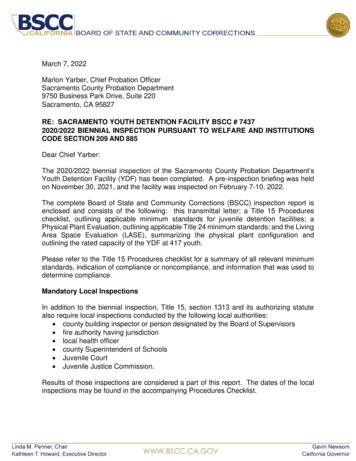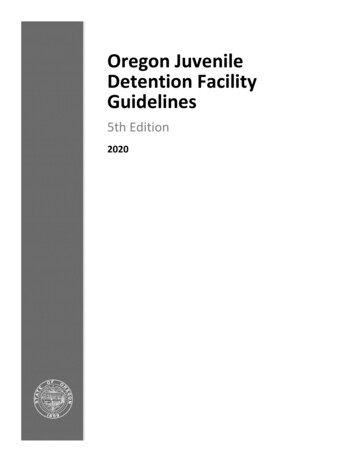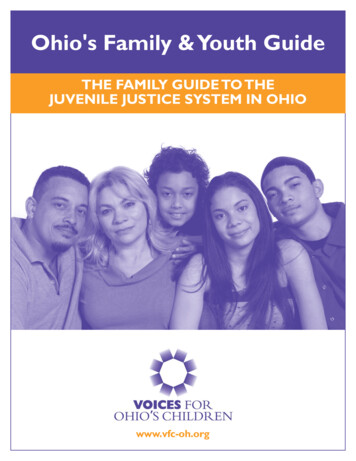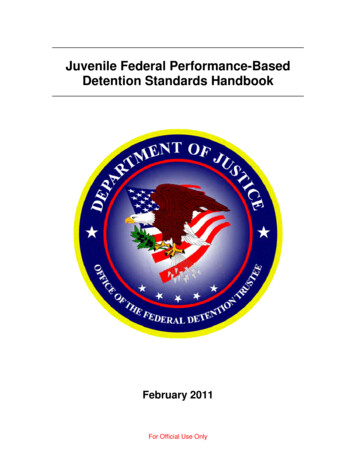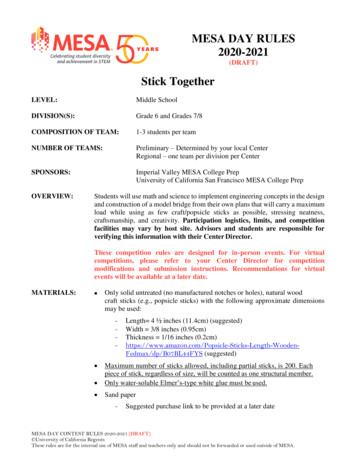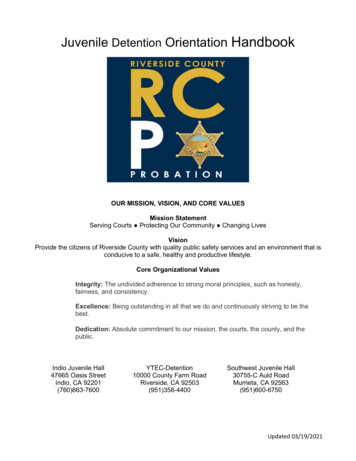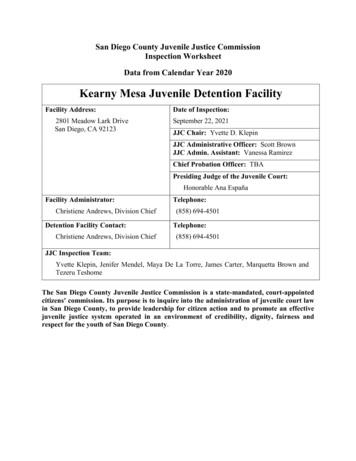
Transcription
San Diego County Juvenile Justice CommissionInspection WorksheetData from Calendar Year 2020Kearny Mesa Juvenile Detention FacilityFacility Address:2801 Meadow Lark DriveSan Diego, CA 92123Date of Inspection:September 22, 2021JJC Chair: Yvette D. KlepinJJC Administrative Officer: Scott BrownJJC Admin. Assistant: Vanessa RamirezChief Probation Officer: TBAPresiding Judge of the Juvenile Court:Honorable Ana EspañaFacility Administrator:Christiene Andrews, Division ChiefDetention Facility Contact:Christiene Andrews, Division ChiefTelephone:(858) 694-4501Telephone:(858) 694-4501JJC Inspection Team:Yvette Klepin, Jenifer Mendel, Maya De La Torre, James Carter, Marquetta Brown andTezeru TeshomeThe San Diego County Juvenile Justice Commission is a state-mandated, court-appointedcitizens' commission. Its purpose is to inquire into the administration of juvenile court lawin San Diego County, to provide leadership for citizen action and to promote an effectivejuvenile justice system operated in an environment of credibility, dignity, fairness andrespect for the youth of San Diego County.
San Diego County Juvenile Justice CommissionKearny Mesa Juvenile Detention Facility 2020TABLE OF CONTENTSA. Institution Overview . 7B. Education/Training . 8C. Commission Comments and Recommendations . 9A. Population and Staffing Information . 14B. Admissions and Orientation . 14C. LGBTQI Admissions . 15D. Personal Property and Money. 16E. Youth Records . 16F. Classification, Review, and Housing . 16G. Access to Legal Services . 16H. Telephone and Video Conferencing (Skype) Access . 16I. Family Visits. 17J. Mail and Email . 17K. Staff-Youth Communications . 18L. Grievances . 18M. Clothing and Bedding . 19N. Non-Hazardous Furnishings . 19O. Personal Hygiene/Showers . 19A. Staffing . 20B. Capacity and Attendance . 20C. Absences . 21D. Supplies . 21E. High School Diploma and HiSET Programs . 22F. Special Education . 23G. General Education Teachers . 24H. Credentialed Special Education Teachers . 25I. IEP Meetings . 25J. General Special Education Questions. 26K. Post-High School/HiSET Programs . 26
San Diego County Juvenile Justice CommissionKearny Mesa Juvenile Detention Facility 2021L. Career Technical Education (CTE) . 26M. Special Programs and Activities . 27N. Independent Study . 27A. Medical Staffing . 28B. Health Screening. 28C. Medical and Dental Health Needs . 28D. Intoxicated Youth . 29E. Hunger Strikes . 30F. Suicidal Ideation . 30G. Death . 31H. Informed Consent/Involuntary Treatment . 31I. Experimental Research . 31J. Infectious Disease . 31K. Accommodations for the Disabled . 31L. Accommodations for Autism or Other Developmental Disorder . 31A. Evidence Based Practices/Programs . 32B. Religious Practices . 41C. Work Assignments . 41D. Exercise and Out-of-Sleeping Room Opportunities . 42E. Transition and Release. 42A. Security Features . 43B. Security Inspections . 43C. Control of Contraband . 43D. Searches . 43E. Discipline . 43F. Serious Incidents. 45G. Use of Force. 45H. Use of Oleoresin Capsicum (OC or Pepper) Spray . 45I. Use of Restraints . 46J. Room Confinement. 46
San Diego County Juvenile Justice CommissionKearny Mesa Juvenile Detention Facility 2021A. Fire Safety. 47B. Control of Dangerous and/or Toxic Materials . 47C. Environmental Control . 47D. Physical Facility and Equipment . 47E. Tool and Equipment Control . 47F. Weapons Control . 47G. Contingency and Emergency Plans . 47A. Sanitation and Meal Service . 48B. Adequate and Varied Meals . 48C. Special Diets . 48A. Post Orders . 49B. Policy Development and Monitoring . 49C. Interpersonal Communication and Diversity Training . 49D. Internal Inspections and Reviews . 49E. Staff Background and Reference Checks . 50F. Staff Training, Licensing, and Credentialing . 51G. Staff Misconduct. 52A. Changes in Funding . 53B. Budget . 53
San Diego County Juvenile Justice CommissionKearny Mesa Juvenile Detention Facility 2021Executive SummaryFor the second year in a row the facility inspection was conducted virtually as a precaution duethe on-going COVID-19 19 pandemic. The review included a review of the pre-inspectionworksheet submitted to the Commission (included in this report), interviews with administrativestaff, line staff and collaborative partners. Youth were not interviewed during this inspection.Members of the Commission agreed youth input is important and needs to be heard therefore aseparate report will be published to ensure the youth voice does not get lost.Due to the pandemic a number of Commission recommendations from the 2019 and 2020inspections have not been implemented. The Commission will continue to review their progress.The school continues to have a working relationship with facility staff and report greatcommunication and collaboration. There is a transition specialist on staff to assist youth withtransition back to school in the community. There is increased participation with ZOOM meetingsregarding a youth’s IEP with the school of origin participating. Distance-learning occurred in 2020but the school has since returned to in-person learning. The Beat Within continued throughout2020 and is a publication that the youth are able to express themselves creatively. With all theobstacles due to the pandemic, the school was able to collaborate with partners and continue tooffer college classes to all students at the facility. The School and Probation are commended fortheir efforts in providing higher learning opportunities to the youth. During thepandemic after school programs were suspended. Now that in-person learning hascontinued it would be beneficial to the youth to reinstate a robust after school program.As to other programs there were a variety of partners that conducted programming but as the fiscalyear changed and COVID-19 pandemic heightened programming fell onto the shoulders ofcorrectional staff. Correctional staff are left to create and conduct programming in lieu of programand/or licensed experts. This was the practice of Probation in the 1990’s. Over the years it hasbecome evident experts in the field should conduct evidence-based programs and programmingnot be left to the sworn staff.OC Spray incidents for all facilities were reviewed by Commission members on a separate day atKearny Mesa Juvenile Detention Facility. There were no patterns of usage noted during the review.In calendar year 2020 the facility administration reported 39 instances of OC use as compared to112 the previous year. This is a great decrease from the previous year. Continued decline inpopulation, better staff to youth ratios as well as increased opportunities to engage youth certainlyare factors that can contribute to this. The Commission looks forward to Probation continuing todecline and eventually ceasing the use of OC spray. In the pre-inspection work sheet, the ProbationDepartment answered yes to H 3 (a) in that OC documents are reviewed by the administrator incharge and number 4 had the box checked that the level of review included the Division Chief. Itis noted that over 70% of the OC incident reports reviewed for Kearny Mesa Juvenile DetentionFacility had no documentation to support they had been reviewed by the Division Chief. This issignificant as the Division Chief needs to have a pulse on the OC use and review of the reports areessential.The facility reported 10 suicide attempts in 2020 with none being successful. Behavioral Healthcontinues to offer services to youth. They are on-site seven days per week, conduct individual andin some cases family therapy and participate in multi-disciplinary meetings. They continued5
San Diego County Juvenile Justice CommissionKearny Mesa Juvenile Detention Facility 2021transition to the community services but due to the pandemic many were completed by phone withsome being face to face in the community/home.From the previous year’s inspection, the Juvenile Justice Commission recommended a review ofmedical services, in particular to “med pass” (when youth receive their medication). It was reportedthere are times only one nursing staff is on at a time and with intakes, emergencies, and “med pass”there are times medication is given late. The Department noted an additional 28 hours of eveninghours. This appears not to have solved the problem as there is still only one nurse on shift at times.The one nurse on duty is pulled in multiple directions that include but are not limited to emergencycalls, OC incidents, intakes, releases, “med pass”, sick calls and assisting mental health staff. It isrecommended the Department provide additional medical coverage with nurse input to ensurecoverage is appropriate so that response times for intakes, emergencies and “med pass” can occurin a timely manner without interruption and continue to support the needed hours in future years.It was also noted that there is no clerical support for the clinic. With medication and medicaldocumentation that is necessary clerical services are imperative and functions they can providecan allow more time for nursing staff to provide medical services while allowing them time for abreak in their 12-hour schedule.Also of note is the “Crash Cart” was taken away. Now when nursing staff respond to a medicalemergency, they are limited in what they can carry. This has created a situation where Probationstaff are relied upon to go find needed items in the clinic during an emergency as the medical staffcannot leave the patient. A medical cart is imperative for the potential to save lives.As to Behavioral Health STAT continues to provide mental health services to youth in thedetention facility. They are scheduled to be on-site seven days per week. There is an on-callpsychiatrist during off hours. In collaboration with others in the facility there were programsdelivered during May which included Mental Health Awareness month, in September SuicidePrevention Awareness and stress management related programs.Having a good working collaborative relationship is important to providing services to help youthsucceed. While the school maintains a good working relationship with Probation the same was notdisplayed in regards to Behavioral Health with Probation and the Clinic. In many interviews thetheme was there is a lack of a positive working relationship between Behavioral Health andProbation staff and the clinic in general. It is imperative that all entities work together at all levelsto increase the success for the youth in custody.Good morale and maintaining that level of morale can be difficult especially during times like thepandemic. In talking with various staff, both probation and collaborative, there are challenges thatleave staff morale low. Not only is there a shortage of staff (vacancies, sick calls, vacation andtime off creates the staffing problem), funding is continually cut and programs such as“BridgeWays” and the like are cut. These are valuable services to the youth in custody. Anotherarea that causes low morale is that of transparency. The staff feel the facility administrators andthe Deputy Chief are transparent but beyond that there is a feeling of no transparency by theExecutive level which causes a lack of trust. Many staff also struggle as they are in the dayto-day operations of the facility yet they were not part of the planning or changes with EastMesa and Kearny Mesa facilities. At the time of the inspection, staff were unaware ofassignments in the near future and the distance to travel to East Mesa with the closure of KearnyMesa facility created a lot of stress for staff working in the facility. Also, staff related the BBQsthey did in the past were canceled due to the pandemic. As things continue to improve theDepartment should allow the staff to have BBQs and the like to build morale, relationships and to6
San Diego County Juvenile Justice CommissionKearny Mesa Juvenile Detention Facility 2021cope with the emotional fallout from COVID-19. Having executive staff from the ExecutiveDeputy Chief to the Interim Chief Probation Officer visit the facilities would improve themorale. As of now many staff at the facility do not feel they are backed by said executive levels.Staff relayed they would like the Executive Deputy Chief, Assistant Chief and Interim Chief to“show up and talk to us.” The staff would like direct contact so the Executives can see how thestaff are actually doing. The staff relayed shift leader briefings were stopped due to thepandemic. This is an important way to pass information on shift to shift. The staff felt thebriefings could have continued by moving it outside, by social distancing or doing so virtually.With the passage of SB823 (Juvenile Realignment), and the closure of Department of JuvenileJustice (DJJ), staff feel unprepared to receive these youth. The Department has begun to work ona plan with the assistance of juvenile justice partners and community agencies. The staff arenot aware of the progress being made. More transparency and on-going information sharingcould assist in lessening their concerns.One final area of note is that of Policy and Procedure revisions. In the past four years duringinspections there has been a discussion of policy and procedure updates. TheProbation Department relays they are in the process of revising the policies and procedures.The revisions should have been completed by now. Of concern is that procedures are not in linewith policy as has been noted by the Juvenile Justice Commission in past years. TheBoard of State and Community Corrections has also noted policies and procedures need toupdated in their 2018-2020 Biennial Inspection Cycle Report.A. Institution Overview1. Population Trends & StaffingHow many youths were diverted from custody during the intake process? 38Where were the youths diverted to? Thirty-four were released as a promise to appearto a parent, guardian, or responsible relative, 1 was released to home supervision, and3 were released to a community-based organization/Alternatives to Detention.How many youths were brought to the facility under the age of 12? 0How many were detained? N/A2. Educational AchievementsEducational AchievementHigh School DiplomaCollege Courses# of Participants1031 (some participants 3counted more than once dueto multiple detentions50# of Graduates3. Are programs in the facility evidence-based programs or evidenced based practices?Data and Outcomes for Programs: Programs provided to youth are now consolidatedunder the Bridgeways contract which is overseen by the Health and Human ServicesAgency7
San Diego County Juvenile Justice CommissionKearny Mesa Juvenile Detention Facility 2021Repeat Clients: YesHow do you determine who receives what services? .4. Serious Incidents Trends and Use of Pepper Spray: All direct care staff attended MOVINGTOWARDS A MORE TRAUMA - INFORMED & RESPONSIVE JUVENILE JUSTICESYSTEM within the 2020-2021 training year.5. Coordination of Behavioral Health Services Care: Behavioral Health Service and theProbation Department have a collaborative partnership to provide intensive treatment andcare.6. Describe Transition Services and Results: All youth committed to the Youthful OffenderUnit (YOU) and Urban Camp meet with Reentry officers during the duration of theircommitment. The San Diego County Probation Reentry Model includes six phases including:Assess, Engage, Plan, Link, Monitor and Advocate.7. Trauma Informed Staff training and impact: All direct care staff attended MOVINGTOWARDS A MORE TRAUMA - INFORMED & RESPONSIVE JUVENILE JUSTICESYSTEM within the 2020-2021 training year.B. Education/Training1. Career and Technical Education: The JCCS Transition Specialists provide technicalresources to the SOAR Academies and schools operated by the San Diego County Office ofEducation (SDCOE Schools) for students transitioning between the local school districts andthe SOAR Academies.2. Community Tutoring/Mentoring Programs: Reentry planning for our students in the SOARAcademies begins as soon as the student is remanded to the SD County Juvenile DetentionFacility. All students are interviewed by our School Counselor, Student Support Specialists,and a Transition Technician within 48 hours of confinement. At this meeting, it is of theutmost importance that student voice and choice are taken into consideration. Studentsreview their academic, vocational, career, and educational goals in order to prepare them forthe day they are released from custody. As soon as the intake process is completed, thecounselor, transition specialist, and Educational Specialist (Special Education case manager)begin communicating with the probation officers as to the educational needs, transition plan,and aspirations of our students. It is imperative that there is open communication between allstakeholders that are or will be supporting the student. Our Transition Technician is the keyeducation member of the Multi-Disciplinary Team (MDT). This team consists of the student,family/guardian, education, institutional probation officers, home-based supervisionprobation officers, medical personnel, and community service providers. The team meets tocreate a plan that incorporates the following: (a) Educational goals (b) List theaccommodations, modifications, and/or supports the student may need if the student has anIEP or 504 plan. (c) Share information with home supervision probation and the receivingschool district in order to prevent any delay in the student returning to their school of choice.(d) Provide for a means of ongoing communication between probation and the school whilethe student has been assigned formal or informal probation requirements. Lastly, transitionmeetings are held for all adjudicated students and our pre-adjudicated students to the greatestextent possible exiting the SOAR Academies, including, but not limited to the following: thestudent, education rights holder, parent/guardian, the school counselor, the transition8
San Diego County Juvenile Justice CommissionKearny Mesa Juvenile Detention Facility 2021technician, special education representatives if applicable, the district of residencerepresentatives, social3. Programs/Evidenced Practices (See table to be included): N/A4. Critical Incident Reports and STAT Team: N/A5. LGBTQI Training/Support-accommodations: N/AC. Commission Comments and Recommendations1. Follow Up from 2020 Recommendations:a. The Commission recommends all staff (Probation and collaborative) receive thesame training regarding Trauma.i. Probation Response: The Probation Department is collaborating with SanDiego State University to provide training to staff in the areas of: AdolescentBrain Development, Trauma-Informed Care, Implicit Bias, and RestorativePractices, while continuing to explore opportunities to enhance and expandtraining opportunities for staff in Juvenile Institutions CORE training. Over thepast year, Probation has been increasing requirements in new contracts forproviders to receive these trainings but has not specified the provider. Startingin fiscal year 2021-22, when the new San Diego State University Academy forProfessional Excellence (Academy) contract begins, Probation will be directingnew contracts to receive training from the Academy for consistency and bestpractices.b. The Commission recommends the Probation Department inform all collaborativestaff on where to find the Facility Policy and Procedure Manual and review whichpolicies collaborative staff are required to review.i. Probation Response: The Probation Department is in the process oftransitioning our policy and procedures to a new format. As this projectprogresses, the policy documents will be moved to a more accessible format.They will also continue to be reviewable through our public facing website. Wewill work to ensure that collaborative partners are educated about where theycan access them.c. The Commission recommends the facility use Harm Resistant Blankets for allyouth.i. Probation Response: The Probation Department has procured 175 HarmReduction Blankets to date and additional purchases are planned. Thedepartment currently provides Harm Reduction blankets to all female youth andthose youth who have been identified as at risk for self-harm and anticipatesexpanding their use as supply increases, with the goal of replacing all bedding.d. The Commission recommends the Department continue to use the current staffinglevels to reduce and eliminate the use of OC spray.i. Probation Response: The Probation Department continues to implement astaffing model that is supported by national best practices and is committed todeveloping a positive youth development culture where violence is minimal,and staff do not feel the need to carry OC spray for their own safety. TheProbation Department is also training all direct care staff in the areas ofAdolescent Brain Development, Trauma-Informed Care, Implicit Bias, and9
San Diego County Juvenile Justice CommissionKearny Mesa Juvenile Detention Facility 2021e.f.g.h.i.Restorative Practices. It is anticipated that this will improve communicationand rapport between staff and youth and result in a reduction of seriousincidents and the use force including OC spray. The Department remainscommitted to fully implementing the Mandt System in Fiscal Year 2021-22.The Commission recommends the Probation Department review incident reportscollectively in order to ascertain who is using OC spray and when it is being usedto assist in decision making to ensure youth safety.i. Probation Response: When OC spray is used, it is always documented in theform of a written incident report. From these reports we are able to collect dataon the frequency, amount and which specific officers are using this type of force.This data is regularly reviewed at a department executive level and at the
continued it would be icial to the youth to reinstate a robust after school program. benef As to other programs there were a variety of partners that conducted programming but as the fiscal year changed and COVID-19 pandemic heightened programming fell onto the shoulders of correctional staff.
